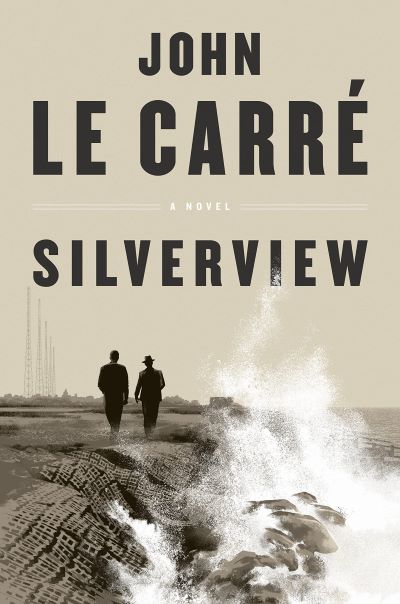Silverviewby John le Carré
Reviewed by Michael Attard

John le Carré is the author of 26 spy novels; several have been adapted to film. His careers in the British Security Service, M15, and the British Secret Intelligence Service, M16, have provided the backbone for his work. Silverview, his last book, was published posthumously by his son in 2021. The son states that the novel was completed, but interestingly, it is the shortest of his books, and several reviewers, including myself, have assessed that the story concludes without a proper ending.
Circumstances revolve around 33-year-old Julian Lawndsley, a formerly successful trader who has exchanged his hectic London life for the quieter lifestyle of an English countryside book seller. However, Lawndsley is not the main character. Rather, this would be Edward Avon, who goes by various names. The moral dilemma is never more than implicit, but struggles with keeping a balance between serving his adopted country and his private morals. He is married to a spy. The peculiar situation is such that one comes to see “…the entire Avon clan and its offshoots as being united, not in the secrets they shared, but in the secrets, they kept from one other.”
The antagonist is Stewart Proctor, who claims to be following up on a technical error but in actuality is in pursuit of Avon. In spy terms, Proctor believes that Avon has ‘gone over.’ Avon and Proctor never meet, which lends credence to the theory that the author never completed his story. Proctor and the reader learn a great deal about Avon through an interview that Proctor has with a retired spy couple. These pages are an example, where there is a lot of explanation, but throughout, the story is sparse on action.
As to why Avon would ‘go over,’ it is never made clear. He was a spy whose loyalty had never been in doubt. We learn that at one point, Avon had returned to England from the Balkans in bad shape. “He’d seen bad things. Atrocities. Murdered children.” It helps if the reader has some understanding of actual events to make sense of the story, but even then, it is not clear as to whom Avon would have gone over to. I suppose the intrigue and mystery may have been purposely created, demanding the reader to pay close attention. Or it could be a weakness of plot.
Trying to follow the plot is not made easier by the punctuation and the intermingling of what people say with what they are thinking. At other times when people are speaking, they relay to the reader another character’s statements, in a manner as if they are that person. For example, within a single set of quotation marks, Avon’s daughter, Lilly, is speaking about her mother: “What else do you do Mum? Protect our country from its enemies, darling. As I hope you will do one day.”
The reading is kept interesting by the well-drawn characters. The author has penetrated deeply into their personalities; they are believable, and worthy of our empathy. And even though the story is about a group of spies, the candor between them creates a real-life intellectual sharpness within the intrigue.
Lawndsley and Avon become friendly more than friends, and even though Lawndsley [IW4] is unknowingly drawn into the spy world, he is never in any danger. In fact, there is not really ever any danger, which diminishes the appeal of a spy novel. There are a couple of mysterious and, of course, very attractive women. But their roles are minimal at best, and while what they reveal allows insight, the lack of suspenseful action leaves the reader feeling somewhat flat.
Other minor characters and side plots seemed like page fillers to me. We are introduced and told quite a bit about the character Stewart Proctor’s children. Why? I do not know; they have nothing to do with the story. We learn that Avon has been selling rare Chinese porcelain on the side. Other than to introduce us to characters who tell us more about Avon I did not see a connection to his spying.
Eventually, there is a communication between Avon and Proctor, and they agree to meet in person. Still, in spite of traitor allegations, there is no sense of hostility or danger. In fact, as Proctor is driving to meet Avon, he thinks of the document that he wants Avon to sign as a “stay-out-of-jail card.” Not surprisingly, Avon never shows up at the designated rendezvous location. Suddenly, there is a bit of back and forth as the Secret Intelligence Service realizes that Avon is trying to outrun them. The story concludes with Avon’s daughter who, when referring to Proctor as “he,” states, “He won’t find him.” And the book is done.
Thus, just as things were getting interesting, with a bit of a chase, it is over. I do not see how readers can feel otherwise than that they have been cheated of an ending. There were absolutely no idiosyncratic clues planted here and there suggesting a planned escape that would become clear in hindsight. I feel obliged to conclude by saying that John le Carré has been acclaimed as one of the greatest literary writers of the post-Cold War era. It was perhaps just my bad luck that I picked up this posthumously published work.
The Reviewer
Michael Attard is a Canadian who has lived in Gwangju since 2004. Though officially retired, he still teaches a few private English classes. He enjoys reading all kinds of books and writes for fun. When the weather is nice, you may find him on a hiking trail.




